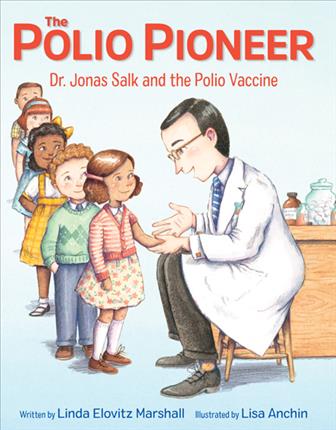| Polio pioneer : Dr. Jonas Salk and the polio vaccine Author: Marshall, Linda Elovitz | ||
| Price: $23.08 | ||
Summary:
The fascinating life of world-renowned scientist Jonas Salk, who invented the polio vaccine.
| Illustrator: | Anchin, Lisa |
| Accelerated Reader Information: Interest Level: LG Reading Level: 4.50 Points: .5 Quiz: 513091 |
Reviews:
Kirkus Reviews (05/15/20)
School Library Journal (08/28/20)
Booklist (06/01/20)
The Bulletin of the Center for Children's Books (A) (00/07/20)
Full Text Reviews:
Booklist - 06/01/2020 The son of Jewish immigrants who valued education and good works, Jonas Salk grew up to become a doctor and a researcher. He helped develop a vaccine that offered protection against flu viruses, which had reached pandemic levels when Salk was a child. Later, he led his own lab in creating a safe vaccine preventing polio, another viral disease that was infecting an increasing number of people, particularly children. After his effective vaccine became widely available, it eliminated polio in almost every country. And Dr. Salk returned to his lab to work on other diseases. Marshall introduces Salk as a kindly person who worked hard, using his wits and education to help others. The acrylic, gouache, and pencil illustrations recreate period settings and clothing well while reinforcing the factual content and amiable tone of the text. There’s no denying the timeliness of this picture book biography, and its recognition of the benefits of vaccination is equally important. A reassuring biography of a dedicated scientist who worked diligently, developed a successful polio vaccine, and gave it to the world. - Copyright 2020 Booklist.
School Library Journal - 08/28/2020 Gr 1–5—This timely picture book biography describes the life and scientific contributions of Dr. Jonas Salk (1914–1995). A sensitive, studious child, Salk was born in New York City to poor Eastern European Jewish refugee parents. He attended the City College of New York and later studied medicine at the New York University School of Medicine, where he met his mentor and friend, Dr. Thomas Francis. Together, they collaborated on the first flu vaccine in response to the 1918 pandemic. Their hard work paid off; their vaccine was a success. Years later, Salk created a vaccine for polio, a disease that "paralyzed or killed thousands of people every year, including many babies and small children." For several years, communities closed swimming pools, beaches, and movie theaters to manage the spread…sound familiar? Almost two million youngsters, dubbed "Polio Pioneers," voluntarily took the new vaccine before it was deemed safe and effective. On April 12, 1955, Salk announced the vaccine's success to the world. Anchin's colorful illustrations are rendered in acrylic gouache and pencil. Children and scientists of diverse skin colors, religions (both a yarmulke and hijab are shown), and genders are depicted. One page features children in their homes looking out the windows at empty streets. Marshall's author's note offers a personal reflection on the polio years. VERDICT A recommended purchase for most libraries. This title explains how vaccines work, provides historical context, and inspires the hope of a victory over the current pandemic.—Barbara Auerbach, Cairo P.L., NY - Copyright 2020 Publishers Weekly, Library Journal and/or School Library Journal used with permission.



